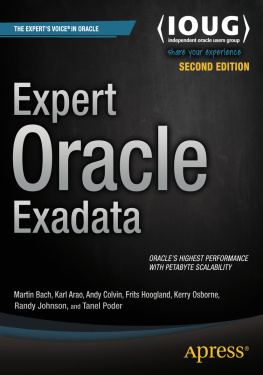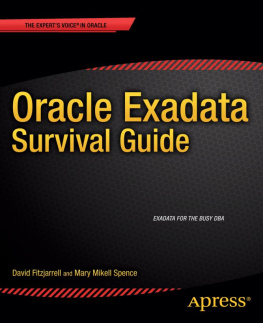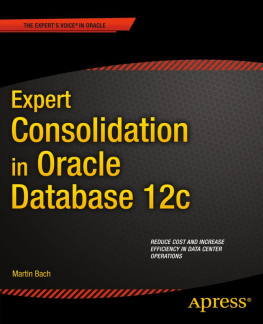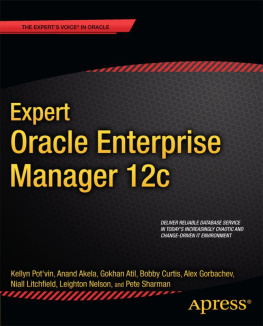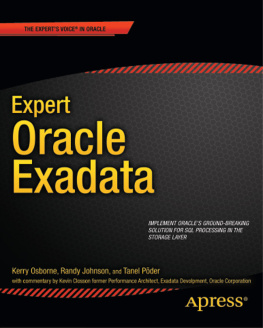Martin Bach Karl Arao Andy Colvin Frits Hoogland Kerry - Expert Oracle Exadata
Here you can read online Martin Bach Karl Arao Andy Colvin Frits Hoogland Kerry - Expert Oracle Exadata full text of the book (entire story) in english for free. Download pdf and epub, get meaning, cover and reviews about this ebook. City: Berkeley;CA, year: 2015, publisher: Apress, Imprint: Apress, genre: Romance novel. Description of the work, (preface) as well as reviews are available. Best literature library LitArk.com created for fans of good reading and offers a wide selection of genres:
Romance novel
Science fiction
Adventure
Detective
Science
History
Home and family
Prose
Art
Politics
Computer
Non-fiction
Religion
Business
Children
Humor
Choose a favorite category and find really read worthwhile books. Enjoy immersion in the world of imagination, feel the emotions of the characters or learn something new for yourself, make an fascinating discovery.
- Book:Expert Oracle Exadata
- Author:
- Publisher:Apress, Imprint: Apress
- Genre:
- Year:2015
- City:Berkeley;CA
- Rating:3 / 5
- Favourites:Add to favourites
- Your mark:
- 60
- 1
- 2
- 3
- 4
- 5
Expert Oracle Exadata: summary, description and annotation
We offer to read an annotation, description, summary or preface (depends on what the author of the book "Expert Oracle Exadata" wrote himself). If you haven't found the necessary information about the book — write in the comments, we will try to find it.
Expert Oracle Exadata — read online for free the complete book (whole text) full work
Below is the text of the book, divided by pages. System saving the place of the last page read, allows you to conveniently read the book "Expert Oracle Exadata" online for free, without having to search again every time where you left off. Put a bookmark, and you can go to the page where you finished reading at any time.
Font size:
Interval:
Bookmark:

- V1: The first Exadata was released in late 2008. It was labeled as V1 and was a combination of HP hardware and Oracle software. The architecture was similar to the current X5 version, with the exception of Flash, which was added to the V2 version. Exadata V1 was marketed exclusively as a data warehouse platform. The product was interesting but not widely adopted. It also suffered from issues resulting from overheating. The commonly heard description was that you could fry eggs on top of the cabinet. Many of the original V1 customers replaced their V1s with V2s or X2-2s.
- V2: The second version of Exadata was announced at Open World in 2009. This version resulted from a partnership between Sun and Oracle. By the time the announcement was made, Oracle was already in the process of attempting to acquire Sun Microsystems. Many of the components were upgraded to bigger or faster versions, but the biggest difference was the addition of a significant amount of solid state-based storage. The storage cells were enhanced with 384G of Exadata Smart Flash Cache. The software was also enhanced to take advantage of the new cache. This addition allowed Oracle to market the platform as more than a Data Warehouse platform, opening up a significantly larger market.
- X2: The third edition of Exadata, announced at Oracle Open World in 2010, was named the X2. Actually, there were two distinct versions of the X2. The X2-2 followed the same basic blueprint as the V2, with up to eight dual-socket database servers. The CPUs were upgraded to hex-core models, where the V2s had used quad-core CPUs. The other X2 model was named the X2-8. It broke the small 1U database server model by introducing larger database servers with 88 core CPUs and a large 1TB memory footprint. The X2-8 was marketed as a more robust platform for large OLTP or mixed workload systems due primarily to the larger number of CPU cores and the larger memory footprint. In 2011, Oracle changed the hardware in the X2-8 to 8x10-core CPUs and 2TB of memory per node. For customers that needed additional storage, storage expansion racks (racks full of storage servers) were introduced. In January 2012, Oracle increased the size of the high-capacity disks from 2TB to 3TB.
Font size:
Interval:
Bookmark:
Similar books «Expert Oracle Exadata»
Look at similar books to Expert Oracle Exadata. We have selected literature similar in name and meaning in the hope of providing readers with more options to find new, interesting, not yet read works.
Discussion, reviews of the book Expert Oracle Exadata and just readers' own opinions. Leave your comments, write what you think about the work, its meaning or the main characters. Specify what exactly you liked and what you didn't like, and why you think so.

